If food were music, Obe imoyo will be my Love song and eja (fish) will be the lyrics, fresh fish to be precise. I love Nigerian fish stew especially served with boiled yam, Iyoh or ipoko yam from Abakiliki in Eastern Nigeria. This Imoyo is not the same Imoyo from the Caribbean.
There are different types of Imoyo depending on the protein used, chicken, goat, crab etc. This one is made with fish and is also called Obe eja tutu by the Yorubas of Western Nigeria. It is mostly made with fresh fish straight from the river or pond but it will still taste great when made with frozen, dry or smoked fish. You can even use dehydrated fish like stockfish.
The fish is best added raw though people who don’t like the peculiar taste of fresh fish can fry, grill, boil or treat their fish with vinegar, lemon or salt before adding to the stew. The taste of each type of fish and method of processing will definitely affect the taste of the stew.
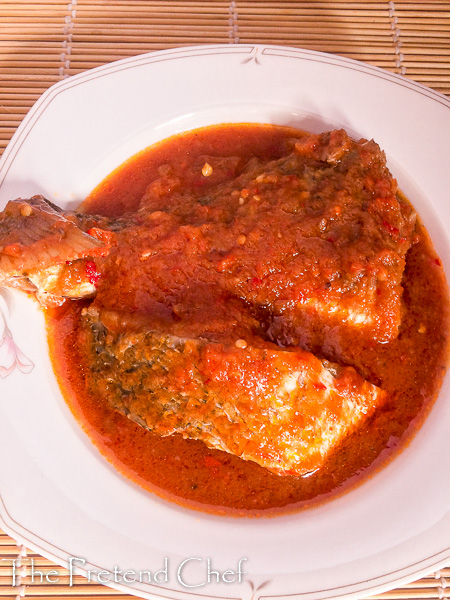
The Nigerian fish stew is a thin sauce, not pepper soup thin but not as thick as the regular Nigerian tomato stew. It is very similar to my Omi obe (stew) but I make certain adjustments to accommodate the fresh fish. I hardly ever use tomato paste for my Omi obe but I add it most times to my Nigerian fish stew (Imoyo), it gives it a smoother mouthfeel. Also, I use much fewer tomatoes in my fish stew.
Some species of tomatoes, even after prolonged boiling, will remain tart. You can add a pinch of sugar, just a pinch to balance the acidity. See my fresh tomato sauce post where I explained this well.
To prepare Nigerian fish stew (Imoyo)
1 kg fish (Croaker, tilapia, catfish etc) 150g onions, sliced (1½ medium) 350g onions 400g tomato 300g tatashe 70g shombo (cayenne) 160g scotch bonnet (fresh pepper) 1/4 cup tomato paste 1 cup Palm oil 5 seasoning cubes salt
Clean, gut and wash fish, cut into the desired size.
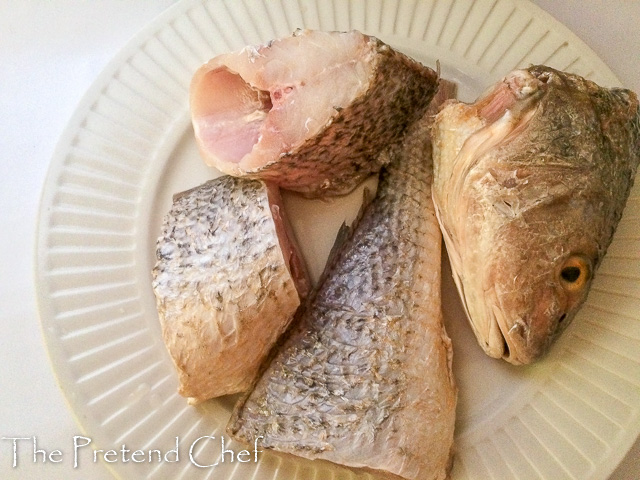
Place fish in a bowl, sprinkle salt and 2 seasoning cubes on it, mix well.
Slice the 150g onions and sprinkle some on the fish, set aside to marinate.
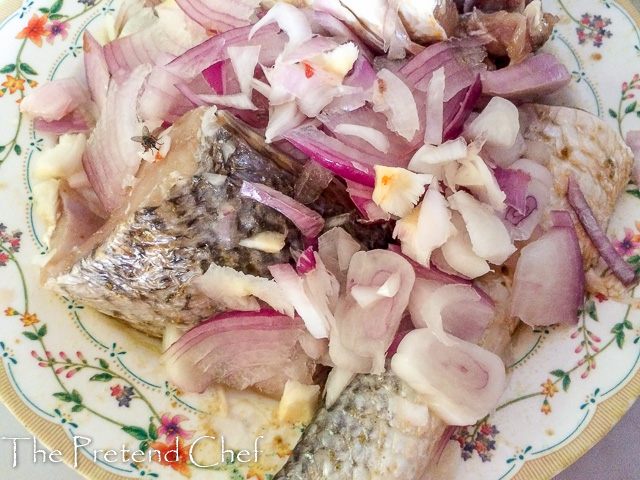
Reserve the other part of the sliced onions.
Remove seeds from tatashe, wash 350g onions, tomatoes, tatashe, shombo and scotch bonnet.
Blend to a smooth puree.
Mix with the tomato paste and set aside.
Pour palm oil into a dry pot and set over medium-high heat. When very hot, add the reserved sliced onions.
Fry until the onion begins to turn brown.
Pour in blended tomato, add seasoning cubes and salt, stir and leave to boil.
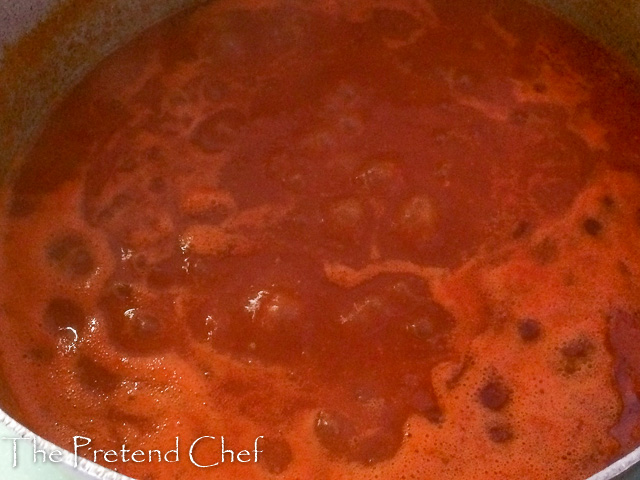
Boil until the stew has reduced and some oil starts to float on top of the boiling stew, about 20 minutes.
Add the fish with onions and 2 cups of water (the water cooks the fish without drying out the stew).
Gently shake and rotate the pot and push the fish in, submerging it in the stew, cover and cook until fish has softened about 10 minutes.
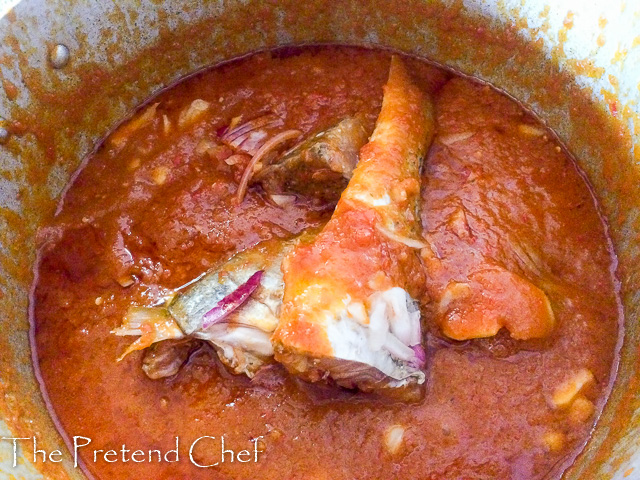
Taste and correct seasoning.
Take off the heat and enjoy.
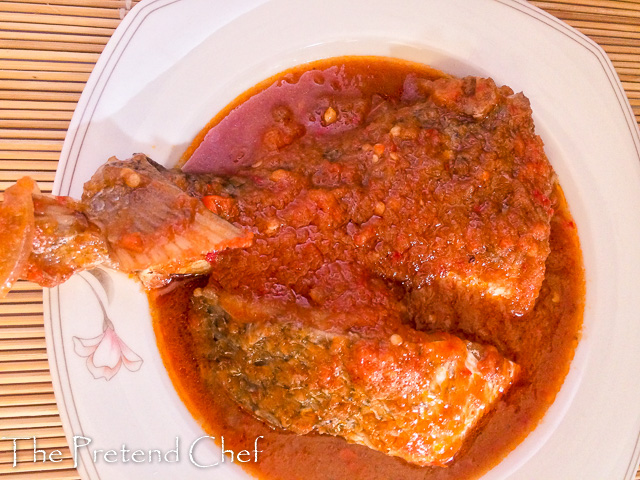
Serve your Nigerian fish stew with boiled yam, plantain, sweet and Irish potato, any fufu of your choice paired with some steamed vegetables e.g okro, ewedu (jute leaves), spinach etc.
Note
- If using croaker fish, remove scales, pour salt and rub in, then pour warm water over it. Leave to stand a few minutes, drain and rinse well in cold water.
- If using frozen fish, defrost fully before using. This also applies to the cooked stew, leave to defrost fully in the refrigerator before reheating.
- Be cautious about the quantity of scotch bonnet used bearing in mind that shombo (cayenne pepper) is also hot, reduce to suit your heat tolerance.
- Do not bleach your palm oil, this stew needs the flavour of unbleached palm oil.
- When the tomato is poured into the hot oil, it will spit a lot, so be careful.
- If the stew is way too light/watery, you can pick out the fish and give the stew a few more minutes of boiling, then put the fish back.
- Fish stew needs more seasoning than meat stew because meat produces a richer stock than fish.
You will also enjoy my Palm nut stew (Stew Akwu), Fresh tomato sauce, Quick and easy tomato sauce and Omi Obe (stew).
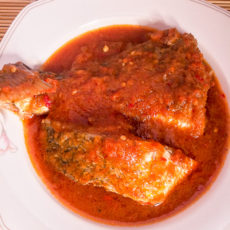
Nigerian fish stew (Imoyo)
Ingredients
- 1 kg fish (Croaker, tilapia, catfish etc.)
- 150 g onions sliced (1½ medium)
- 350 g onions
- 400 g tomato
- 300 g tatashe
- 70 g shombo (cayenne)
- 160 g scotch bonnet (fresh pepper)
- ¼ cup tomato paste
- 1 cup Palm oil
- 5 seasoning cubes
- salt
Instructions
- Clean, gut and wash fish, cut into the desired size.
- Place fish in a bowl, sprinkle salt and 2 seasoning cubes on it, mix well.
- Slice the 150g onions and sprinkle some on the fish, set aside to marinate.
- Reserve the other part of the sliced onions.
- Remove seeds from tatashe, wash 350g onions, tomatoes, tatashe, shombo and scotch bonnet.
- Blend to a smooth puree.
- Mix with the tomato paste and set aside.
- Pour palm oil into a dry pot and set over medium-high heat. When very hot, add the reserved sliced onions.
- Fry until the onion begins to turn brown.
- Pour in blended tomato, add seasoning cubes and salt, stir and leave to boil.
- Boil until the stew has reduced and some oil starts to float on top of the boiling stew, about 20 minutes.
- Add the fish with onions and 2 cups of water (the water cooks the fish without drying out the stew).
- Gently shake and rotate the pot and push the fish in, submerging it in the stew, cover and cook until fish has softened about 10 minutes.
- Taste and correct seasoning.
- Take off the heat and enjoy.
- Serve your Nigerian fish stew with boiled yam, plantain, sweet and Irish potato, any fufu of your choice paired with some steamed vegetables e.g okro, ewedu (jute leaves), spinach etc.
Notes
- If using croaker fish, remove scales, pour salt and rub in, then pour warm water over it. Leave to stand a few minutes, drain and rinse well in cold water.
- If using frozen fish, defrost fully before using. This also applies to the cooked stew, leave to defrost fully in the refrigerator before reheating.
- Be cautious about the quantity of scotch bonnet used bearing in mind that shombo (cayenne pepper) is also hot, reduce to suit your heat tolerance.
- Do not bleach your palm oil, this stew needs the flavour of unbleached palm oil.
- When the tomato is poured into the hot oil, it will spit a lot, so be careful.
- If the stew is way too light/watery, you can pick out the fish and give the stew a few more minutes of boiling, then put the fish back.
- Fish stew needs more seasoning than meat stew because meat produces a richer stock than fish.
Do you have any comments, questions or suggestions, please leave a comment below.
Share this recipe using the share buttons. Subscribe to the blog for instant notifications of new recipes.
Follow on Instagram: @thepretendchefofficial, Twitter: @thepretendchef Facebook: https://web.facebook.com/thepretendchef/ and Pinterest: https://www.pinterest.com/thepretendchef/
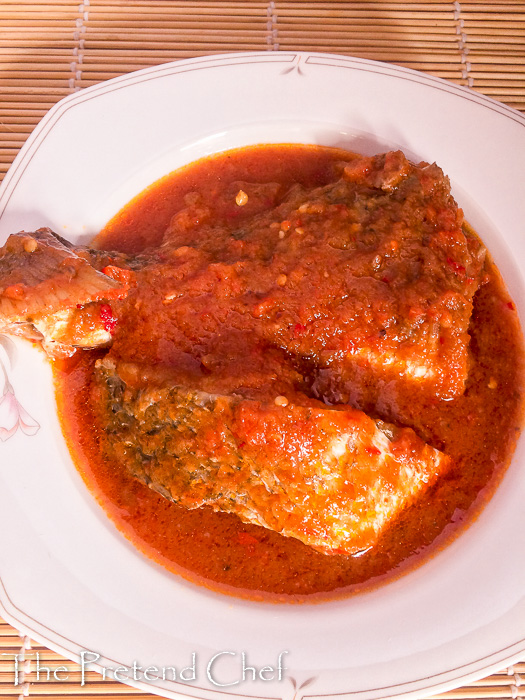
 I am Ganiru, a wife, a mother, a food blogger, a chef, an author and an accountant. I love to cook and write about food, especially Nigerian and afro-centric food...
I am Ganiru, a wife, a mother, a food blogger, a chef, an author and an accountant. I love to cook and write about food, especially Nigerian and afro-centric food...
Pingback: How to kill and process Catfish - The Pretend Chef
Aw, this wɑs ɑn incredibly good post. Finding the time
and actual effort tօ generate a superb article… but wһat can I say… I put things off a ѡhole lot and nevеr manage
to ցet anythіng done.